The University of Miami returned to the No. 44 spot in the 2017 edition of the U.S. News and World Report National University Rankings. The last time UM received a ranking this high was in 2013.
Last year, UM fell to the No. 51 spot, placing it below the University of Florida and falling out of the top 50 national universities.
In the rankings released Tuesday evening, UM is once again the No. 1 ranked school in the state of Florida. UF fell to No. 50 in the U.S. and Florida State University is ranked at No. 92.
UM is in a six-way tie with Lehigh University, UC Davis, UC San Diego, University of Illinois Urbana-Champaign and the University of Wisconsin-Madison.
“Here at the College of Arts and Sciences, our faculty excel in both fundamental and interdisciplinary research,” said Leonidas Bachas, dean of the College of Arts and Sciences, in a statement to The Miami Hurricane. “Our decisions are not based on ways to improve rankings, but rather on what is best for the university, its faculty and students. Of course, we are happy when national rankings validate our efforts.”
U.S. News judges schools on graduation and retention rates, undergraduate academic reputation among academics and counselors, faculty resources, student selectivity, financial resources, graduation rate performance and alumni giving rate.
“[At UM,] the freshman retention rate went from 80 percent to 92 percent over the last 15 to 20 years,” said Thomas LeBlanc, executive vice president and provost. “These improvements in retention and graduation rate are reflected in the improved ranking of UM over that time.”
The largest change that improved the school’s ranking, however, was UM’s reputational score, which increased from 3.2 to 3.3. The score is derived from a survey of counselors, deans and provosts from around the country.
“That reputational score has a heavy weight in the rankings; that alone would have been enough to move us up,” LeBlanc said. “For the last 13 years, we’ve made amazing strides as a university and the reputational score was still at 3.2. So now that it has moved up, that is very significant, especially if it moves up and it stays there.”
Despite the pride that comes with being the best school in Florida, the U.S. News ranking, like any other ranking or polling system, has its weaknesses and flaws. Administrators have cited the lack of diversity criteria as a weakness of the ranking methodology.
“Rankings do not measure everything that is important in education,” Bachas said. “For example, the University of Miami is one of the most diverse universities in the country, but this is not one of the parameters used by the U.S. News and World Report in its ranking.”
LeBlanc also cautions against overemphasizing school rank due to distortions in the numbers.
“As you can see, there’s an enormous amount of compression in the rankings,” LeBlanc said. “Any tiny, tiny movement in any direction could make the difference between being in a six-way tie for 44th, or a seven-way tie for 39th. So I don’t think we should try to read too much into these small year-to-year movements.”
UF, for example, is technically only ranked one spot below UM, but the difference between No. 44 and No. 50 makes the gap seem much wider. Likewise, UM actually falls just one rank under schools like UC Irvine, Boston University (a seven-way tie for No. 39) and three ranks under New York University (No. 36).
Nevertheless, the U.S. News Best Colleges list is still widely cited by news media and used as a reference for counselors, prospective college students and parents around the world.
“I know parents who read the magazine. I suspect international students, who don’t have as much time to visit, will use the rankings as a rough guide,” LeBlanc said. “It does have an impact, and I would much rather be in the top 50 than not, but I do think it’s often overemphasized.”
In other listings by U.S. News, UM was ranked as the 27th-best college for veterans and the 10th-best college for students graduating with the least debt. The average amount of debt for a UM student upon graduation was $19,000.
UM nearly tied with public school Florida International University (No. 9), whose students borrow $18,918 on average, and ranked higher than public school UF (No. 25), whose students averaged $21,028 in debt upon graduation.
“We’ve been working very hard to make sure students graduate with less debt,” LeBlanc said. “For a number of years, the average student debt was around $26,000.”
Looking forward, Bachas credited President Julio Frenk’s Roadmap initiatives and hemispheric vision for the university’s continued drive for excellence.
“The $100 million gift from longtime UM benefactors Phillip and Patricia Frost to support basic and applied science and engineering will bring added momentum to the university,” Bachas added. The dean is a chemist himself and also holds a master’s degree in oceanic sciences.
The full Best Colleges rankings can be found on the U.S. News website. More information can also be accessed through the U.S. News College Compass, a paid subscription service.
This story was updated on Sept. 14 at 10:22 p.m.






